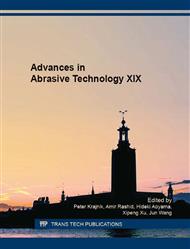p.368
p.375
p.381
p.389
p.395
p.401
p.407
p.415
p.423
Effects of Relative Velocity on Grinding Performances under Si Wafer Rotary Grinding
Abstract:
For the backgrinding of semiconductor devices, a rotary grinding process is indispensable for achieving the required wafer thickness. The relative velocity between the grinding wheel and the wafer is maximum at the periphery of the wafer and minimum at the center of wafer. Generally, the grinding performances are discussed in terms of the ratio of the rotational speeds of the grinding wheel and the wafer. However, it is not possible to use this ratio to determine the grinding conditions for different wafer sizes grinding as this ratio does not show the difference in relative velocity. Therefore, a new relative velocity ratio was defined in this study. Then, the Si wafer grinding was performed to investigate the effect of the surface roughness and the power consumption of the grinding wheel spindle on the relative velocity ratio.
Info:
Periodical:
Pages:
395-400
Citation:
Online since:
October 2016
Authors:
Price:
Сopyright:
© 2016 Trans Tech Publications Ltd. All Rights Reserved
Share:
Citation:


